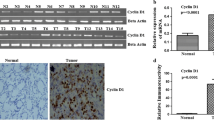Abstract
BACKGROUND: One of the main concerns in colon carcinoma therapy is local recurrence of the malignancy at the site of resection. Previous studies have shown that morphologically normal-appearing mucosa adjacent to colon carcinoma is different from mucosa distant from carcinoma. Mucosa adjacent to a carcinoma is characterized by crypt lengthening, cell hypertrophy, and change in production of mucopolysaccharides from sulfomucin in normal mucosa to sialomucins in carcinomas and adjacent mucosa. Recently there have been reports suggesting that there is an upward extension of the proliferative compartment in colonic crypts of this adjacent mucosa. METHODS: Immunoblot analysis using antibodies to retinoblastoma, statin, c-Fos, c-Jun, and Cdc-2 proteins was used for our study on the expression of early cell cycle genes in carcinoma and its adjacent mucosa. In all, 15 tissue samples obtained from patients with colon carcinoma were analyzed. Tissue specimens were collected and immediately dissected as tumor, 0 to 1, 1 to 2, 2 to 3, 3 to 4, and 4 to 5 cm from the primary lesion. Dissected pieces were homogenized separately and subjected to immunoblot analysis. RESULTS: We found upregulation of c-Fos, c-Jun, and Cdc-2 expression in carcinoma and adjacent mucosa up to 4 cm from the edge of the carcinoma. The phosphorylated form of retinoblastoma is present in the carcinoma as well as in adjacent mucosa up to 4 cm from the margin of the carcinoma. Furthermore, we observed that the level of statin, a nonproliferation-specific nuclear protein, is very low in the primary lesion and in adjacent mucosa up to 3 cm. CONCLUSIONS: These results indicate that adjacent tissue up to 3 to 4 cm from the carcinoma has elevated levels of expression for cell cycle traverse-associated genes and down-regulation of nonproliferation-specific gene expressions such as statin. This imbalance indicates that within 3 to 4 cm from the edge of the carcinoma, colonic epithelial cells are already abnormal and may be in the hyperproliferative and preneoplastic state, susceptible to further steps leading to eventual malignant transformation.
Similar content being viewed by others
References
Weinberg RA. Oncogenes, antioncogenes and the bases of multistep carcinogenesis. Cancer Res 1989;49:3713–21.
Bishop JM. The molecular genetics of cancer. Science 1987;235:305–10.
Vogelstein B, Fearon ER, Kern SE,et al. Allelotype of colorectal carcinomas. Science 1989;244:207–11.
Vogelstein B, Fearon ER, Hamilton SR,et al. Genetic alterations during colorectal tumor development. N Eng J Med 1988;319:525–32.
Fearon ER, Cho KR, Nigro JM,et al. Identification of a chromosome 18q gene that is altered in colorectal cancers. Science 1990;247:49–56.
Griffin MR, Bergstrahl FI, Coffey RJ, Beart RW, Melton IJ III. Predictors of survival after curative resection of carcinoma of colon and rectum. Cancer 1987;60:2318–24.
Philipsen SJ, Heilweil M, Quan SH, Sternberg SS, Enker WF. Pattern of pelvic recurrence following definitive resections of rectal cancer. Cancer 1984;53:1354–62.
Jass JR, Filipe MI. Sulphomucins and precancerous lesions of the human stomach. Histopathology 1980;4(3):271–279.
Shamsuddin AK, Weiss L, Phelps PC, Trump BF. Colon epithelium. IV. Human colon carcinogenesis: changes in human colon mucosa adjacent to and remote from carcinoma of the colon. J Natl Cancer Inst 1981;66:413–6.
Filipe MI, Branfoot AC. Abnormal patterns of mucus secretion in apparently normal mucosa of large intestine with carcinoma. Cancer 1974;34:282–90.
Bibbo M, Michelassi F, Riddel RH, Levin B. Ultrastructure of “transitional” mucosa adjacent to large bowel carcinoma. Cancer 1977;40:2509–22.
Dowson P, Filipe MI. An ultrastructural and histochemical study of the mucus membrane adjacent and remote from the carcinoma of colon. Cancer 1976;37:2388–98.
Bibbo M, Michelassi F, Bartels PH,et al. Karyometric marker features in normal appearing glands adjacent to human colonic carcinoma. Cancer Res 1990;50:147–51.
Mitmaker B, Bayer I, Baytner S, Gordon PH, Wang E. The differential expression of statin in the nuclei of human colonic crypts adjacent to a cancer: an immunohistochemical study. Eur J Histochem 1993;37:43–51.
De Caprio JA, Ludlow JW, Lynch D,et al. The product of the retinoblastoma susceptibility gene has properties of a cell cycle regulatory element. Cell 1989;58:1085–95.
Chen PL, Scully P, Shew JY,et al. Phosphorylation of the retinoblastoma gene products is modulated during the cell cycle and cellular differentiation. Cell 1989;58: 1993–8.
Lipkin M, Blattner WE, Fraumeni JF, Lynch HT, Deschner E, Winawer S. Tritiated thymidine labeling distribution as a marker for hereditary predisposition to colon cancer. Cancer Res 983;43:1899–904.
Wang E. A 57,000-mol wt protein uniquely present in non-proliferating cells and senescent human fibroblasts. J Cell Biol 1985;100:545–51.
Wang E, Krueger JS. Application of a unique monoclonal antibody as marker for non-proliferating subpopulations of cells of some tissues. J Histochem Cytochem 1985;33:587–94.
Author information
Authors and Affiliations
Additional information
Supported by Grant AG07444 (to E.W.) from the National Institute on Aging of the National Institutes of Health.
Read at the meeting of the Royal College of Physicians and Surgeons of Canada, Vancouver, British Columbia, Canada, September 9 to 14, 1993.
About this article
Cite this article
Pandey, S., Gordon, P.H., Wang, E. et al. Expression of proliferation-specific genes in the mucosa adjacent to colon carcinoma. Dis Colon Rectum 38, 462–467 (1995). https://doi.org/10.1007/BF02148844
Issue Date:
DOI: https://doi.org/10.1007/BF02148844




